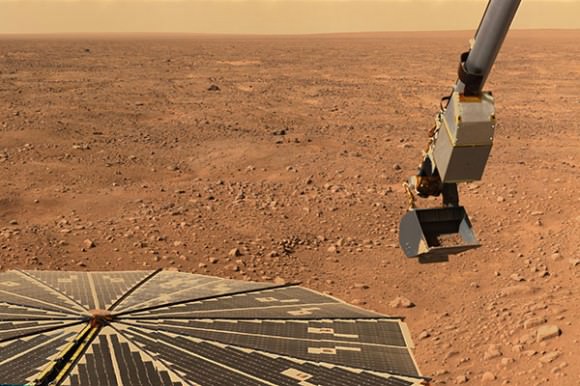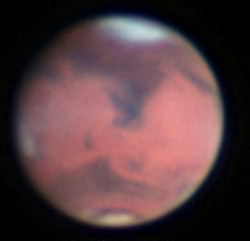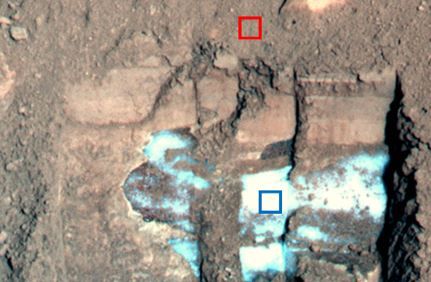Dust on Mars gets everywhere – including on top of ice deposited during one of Mars’ previous ice ages. Just how that dust affects the ice is still up for some debate. Adding to that debate, a recent paper by researchers at Arizona State University and the University of Washington has laid out a map between the dust content of a glacier and the brightness of its ice.
Continue reading “Dusty Snow on Mars Could be Melting Just Below the Surface”NASA Mars Lander InSight ‘Go’ For Construction
It’s time to get ready for Mars, again! NASA has given the approval to begin construction on its 2016 mission, the Interior Exploration Using Seismic Investigations, Geodesy and Heat Transport (InSight) mission.
As the mission implies, the lander (which isn’t moveable) will focus on learning more about the inside of Mars. The idea is to figure out how terrestrial planets are “differentiated” inside between core, mantle and crust. Also, watchers of the Mars program may recognize some parts of the lander, as it will borrow the design from the successful Phoenix mission in 2008.
“We will incorporate many features from our Phoenix spacecraft into InSight, but the differences between the missions require some differences in the InSight spacecraft,” stated Stu Spath, InSight program manager at Lockheed Martin.
“For example, the InSight mission duration is 630 days longer than Phoenix, which means the lander will have to endure a wider range of environmental conditions on the surface.”

NASA mission planners are still determining where InSight will go, but they expect it will be a site near the equator of Mars and that it will last at least two years on the surface.
The Mars lander will include a robotic arm with “surface and burrowing” instruments whose projects are led by the French and German space agencies, which are CNES (National Center of Space Studies) and DLR (German Center for Aerospace), respectively. CNES will contribute a seismic experiment to look at “Marsquakes” and when meteors smack the surface, while DLR’s science experiment will look at interior planetary heat.

The seismometer will sit on the surface, covered up to protect it from the cold and wind, while the heat-flow probe will be hammered in about three to five yards or meters. Investigators also plan an experiment that will communicate with NASA’s Deep Space Network antenna network to see how much the rotation of Mars wobbles, which could hint if the core of the Red Planet is solid or liquid. The mission will also include wind, temperature and pressure sensors, as well as a magnetometer.
“Mars actually offers an advantage over Earth itself for understanding how habitable planetary surfaces can form,” stated Bruce Banerdt, InSight principal investigator at NASA’s Jet Propulsion Laboratory. “Both planets underwent the same early processes. But Mars, being smaller, cooled faster and became less active while Earth kept churning. So Mars better preserves the evidence about the early stages of rocky planets’ development.”
Construction will be led by Lockheed Martin. You can check out more information about InSight at this website. NASA has several missions working at Mars right now, such as the Mars Curiosity rover, the Opportunity rover and the orbiting Mars Reconnaissance Orbiter and Mars Odyssey spacecraft.
Source: Jet Propulsion Laboratory
The Phoenix Constellation
The southern constellation of Phoenix was one of twelve created by Petrus Plancius from the observations of Dutch navigators, Pieter Dirkszoon Keyser and Frederick de Houtman. It first appeared on celestial globe published in the late 1500s and was first depicted in a celestial atlas by Johann Bayer in 1603. Phoenix resides south of the ecliptic plane and covers approximately 469 square degrees of sky, ranking 37th in size. It contains 4 main stars in its asterism and has 25 Bayer Flamsteed designated stars within its confines. Phoenix is bordered by the constellations of Sculptor, Grus, Tucana, Hydrus, Eridanus and Fornax. It is visible to observers located at latitudes between +32° and ?90° and is best seen when it reaches culmination during the month of November.
There is one annual meteor shower associated with the constellation of Phoenix which peaks on or about December 5 of each year – the Phoenicids. The appearance of the meteor was observed by the corps of the first South Pole passing the winter in South Pole observation ship Soya, Japan while toward in 1956 the South Pole it until about 13:45 to 18:00 at the world. The meteor shower is considered to be new and understudied, so there is no predicted fall rate – nor is there an established peak date. The Phoenicids are associated with the comet D/1819 W1 (Blanpain). The comet was observed in 1819 and was missing. However, it turned out that the asteroid 2003 WY25 discovered in 2003 was the same as this comet in 2005. The duration of this shower extends from November 29 to December 9.
Because Phoenix is considered a “new” constellation, there is no mythology associated with it. It is named after the legendary bird which rose from its own ashes. The bird was also said to regenerate when hurt or wounded by a foe, thus being almost immortal and invincible – it is also said that it can heal a person with a tear from its eyes and make them temporarily immune to death; It is a symbol of fire and divinity – also representing the rising and setting of the Sun.
Let’s begin our binocular tour of Phoenix with its brightest star – Alpha – the “a” symbol on our map. Located about 77 light years from Earth, Alpha Phoenicis goes by the traditional name of Ankaa – “the bright one of the boat”. Ankaa is an orange giant star about in the mid-life of its helium burning phase of its stellar evolution. If it continues to behave normally, it will eventually sheds its outer layers in a planetary nebula and ends its life quietly as a white dwarf star. It is known that Ankaa is a double star and has a small stellar companion, but currently little to nothing is known about the companion.
Now, point your telescope at Beta – the “B” symbol on our map. Beta Phoenicis is beautiful, bright yellow double-star is only 1.4 arc seconds in separation, with a position angle of 346 degrees. Other than a companion, it’s a very typical K type star.
How about Gamma the figure “8” symbol? Turn binoculars its way. Located 235 light years away, this rare M-class giant star that puts out 575 times more light than Sol at a very cool 3900 degrees Kelvin. Gamma is evolving a lot faster than our own Sun, passing through a stage where it is an irregular variable star and heading towards being a K-type giant star. Although we know little else, we do know Gamma has a spectroscopic companion, making it a true binary star.
Aim your telescope about 2 degrees northeast of Gamma for NGC 265 (RA 1:35.1 Dec -41:26). At magnitude 12, this fairly small galaxy isn’t going to set any records, but you’ll pick up an elongated form with a bright nucleus. If you see patchy structure in this spiral galaxy, there’s good reason… It’s a Starburst Galaxy!
For a big telescope challenge, try your luck with Abell Galaxy Cluster 2870. Of this galaxy group, the brightest is IC 1625 (RA 01:07:42.4 Dec -46:54:27) and we’re looking at approximately magnitude 13 and about 2 arc minutes in size. It wouldn’t be a challenge if it were easy!



